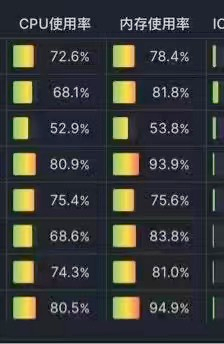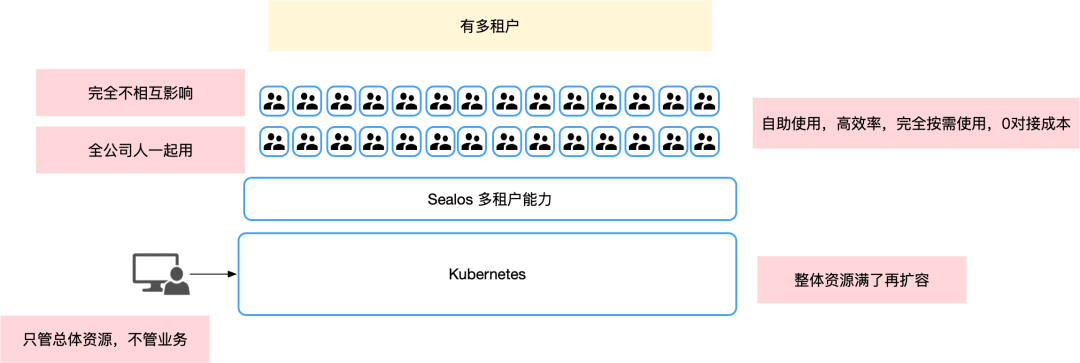This article explains through multi-dimensional and multi-scenario comparisons that Sealos can save a lot of costs for enterprises, and comprehensively analyzes the cost model based on the specific actual situations of some existing customers. Enterprises can make a decision based on their actual situation to see whether it is suitable to use Sealos.
The core cost savings of cloud operating systems are reflected in three aspects: computing power saving, manpower saving, and efficiency improvement.
Computing power savings
Companies that consider saving on computing power costs usually have relatively large computing power and high server resource costs. Calculating the value that Sealos can bring to you is very simple, according to the following formula:
(Company’s overall computing resource cost)* (1-current average resource utilization/Sealos resource utilization) = cost savings

Here, our Sealos average resource utilization online has a reference value of 76.9% (data comes from Sealos online cluster). Enterprises can calculate cost savings by counting their own average resource utilization.
Calculated based on a real customer served by Sealos, their hardware investment is 2.4 million yuan/year, and the overall resource utilization rate is about 15%. Using Sealos can save 240w * (1-15/76.9) = 193w yuan/year in a year. This cost saving is very exaggerated, so if you count the overall resource utilization of the cluster, if it is a very low enterprise, Sealos will bring you a lot of computing resource cost savings.
Manpower saving
Sealos can also save a lot of labor costs for enterprises. It does not mean to replace operation and maintenance, but to let machines do low-end operation and maintenance work, and the saved manpower can be used to do more valuable things, such as the system itself. Function enhancement, business orchestration, etc.
No matter how many people in an enterprise use Sealos, it only takes less than 0.5 people to maintain the system. Therefore, if the enterprise still has a bunch of system maintenance personnel busy maintaining business systems, it should consider using Sealos.
Here is another real case. A certain department of a large listed company has a cluster of 400 servers, with nearly 400 databases running in it, and 40 operation and maintenance and business system maintenance personnel. If Sealos is used, it can reduce To 2 people (backup each other, still drinking tea most of the time). Calculated based on RMB 300,000 per year, it can help enterprises save 38*300,000 yuan = 11.4 million yuan in one year. This is only one department of a certain company. (This is a real example)
Especially in the early stages of system construction, you must choose the right direction, otherwise it will be difficult to return.
A very, very important point is that Sealos will not increase labor costs as enterprise personnel expand, business systems increase, and complexity increases. Our Sealos cloud serves 100,000 registered users and runs tens of thousands of applications. However, we Still only requires one manpower for maintenance (in fact, our company has no operation and maintenance, only development, so the system is stable enough and requires fewer maintenance personnel )
Improved efficiency
The costs caused by inefficiency are often hidden, and companies may not be able to easily discover them, but in fact there are many pitfalls. Every department is busy working, but progress is very slow.
Take a database life cycle as an example.
The process you think of: Get a few servers, download, install and deploy, and done
In fact, your company: The coordination server cannot be coordinated. Wait a week and ask someone who is not professional in high availability to ask the DBA. After using it, it will be turned into a zombie server. Once collaboration between people is involved, the cost of communication and collaboration will become very high. Everyone will be busy and no one will make any progress.
With Sealos, any novice within the enterprise can set up a highly available database (the same applies to other services) within three minutes.
So when we abstract the life cycle of a business, we can find that there are many areas for efficiency improvement:

In terms of environment provision/service dependence/iteration/operation and maintenance, think about how many companies fail to achieve self-service and rely on communication and collaboration between people? Or even need to rely on the assistance of professionals from other departments? There are many points here that can be optimized by the system, thereby exaggeratingly improving efficiency.
Sealos’ cost advantages in the following scenarios
The following is a comparison of several different scenarios to analyze some of the advantages of Sealos compared to the existing scenarios of enterprises. You can take a seat and make a reference.
Physical machine or virtual machine vs Sealos
If an enterprise is still using physical machines or virtual machines, especially in private clouds, but not using containers, it should not hesitate to switch. Even without using Sealos, containerization can bring huge cost savings to the enterprise. This In this scenario, Sealos can bring the greatest cost savings to the enterprise.
The reason is very simple:
How many people can use one server? If more than three developers use it together, it will probably be chaotic. Then there will be endless communication, coordination and resource allocation, and exel cmdb will be overwhelmed.
How many applications can one server run? You can’t tell the difference even if you run ten application ports, right? The file system is in chaos, and the service needs to be maintained by human resources.
Let’s look at Sealos’ model:

The core of Sealos is to turn all resources into a pool. It does not care whether it is one or a hundred, nor whether it is used by one person or ten thousand people, nor whether it is used by one application or one hundred thousand applications. You only need If the overall resources of the cluster are not enough, throw in a few servers. All employees are self-service on cloud operating systems.
Mainstream cloud vendors vs Sealos
Please see price comparison:
| Availability Zone | Resource type/year | Sealos price | Cloud vendor official website price (approximately) | At least cost reduction | CPU/core/year | Memory/G/year | Storage/G/year | Network/G |
|---|---|---|---|---|---|---|---|---|
| Volume price | Price after annual discount | |||||||
| Beijing | 1 CPU 8G memory | 452 yuan/year | 1,700 yuan/year (volcano) | 73% | 149.89 | 75.66 | 4.55 | 0.79 |
| Hangzhou | 1 CPU 4G memory | 731 yuan/year | 1,100 yuan/year (Alibaba Cloud) | 33.50% | 242.39 | 122.25 | 7.4 | 0.79 |
| Guangzhou | 1 CPU 8G memory | 460 yuan/year | 1270 yuan (Tencent Cloud) | 64% | 152.62 | 76.96 | 10.74 | 0.79 |
| Singapore | 1CPU 4G memory | 1770 yuan/year | 2130 yuan/year (GCP) | 40% | 586.92 | 296.01 | 17.94 | 0.79 |
- Sealos itself runs on cloud vendor resources. Why can it be cheaper? The reason is because there are more users and the resource cost can be better when the volume becomes larger.
- Sealos further reduces costs by optimizing resource utilization
- Enterprises no longer need cores, and the above prices are billed by volume. Enterprises can make further cuts by setting flexibility, so the minimum guarantee can reduce costs by more than 50%.
- Enterprises no longer need to pay for running control plane resources, such as k8s management and control service ingress controller, monitoring system, etc., and then cut it again.
Using Sealos can squeeze resource utilization to the extreme.
Cloud native products vs Sealos
If you are already using cloud-native products from various cloud vendors, congratulations! Your company must have achieved a certain degree of cost reduction. Even so, Sealos can still save you a lot of costs, mainly in three aspects:
- There is no premium for cloud products, database middleware, etc. provided by Sealos, and only the resource cost of CPU/memory disk is charged.
- You don’t need to pay an extra dime for all cloud native control planes, you only need to pay for the containers you run, because Sealos implements a multi-tenant sharing model, and all control plane costs are officially borne by Sealos.
- Sealos brings many users together to achieve lower resource costs and higher resource utilization.
This scenario can also save enterprises more than 30% of resource costs.
Summarize
Sealos' vision is to connect computing power and applications through cloud operating systems. Therefore, we will rack our brains to find more cost-effective computing resources for users. We use an asset-light model to maximize the elasticity of the public cloud, and work with mainstream public cloud vendors to help users achieve maximum cost reduction and efficiency improvement. Our pricing model adopts cost pricing to ensure that we can create value for the enterprise as much as possible while ensuring that we can survive healthily, maximize the interests of us and our customers, and ultimately achieve a universal and popular cloud operating system ~
Linus took it upon himself to prevent kernel developers from replacing tabs with spaces. His father is one of the few leaders who can write code, his second son is the director of the open source technology department, and his youngest son is an open source core contributor. Robin Li: Natural language will become a new universal programming language. The open source model will fall further and further behind Huawei: It will take 1 year to fully migrate 5,000 commonly used mobile applications to Hongmeng. Java is the language most prone to third-party vulnerabilities. Rich text editor Quill 2.0 has been released with features, reliability and developers. The experience has been greatly improved. Ma Huateng and Zhou Hongyi shook hands to "eliminate grudges." Meta Llama 3 is officially released. Although the open source of Laoxiangji is not the code, the reasons behind it are very heart-warming. Google announced a large-scale restructuring